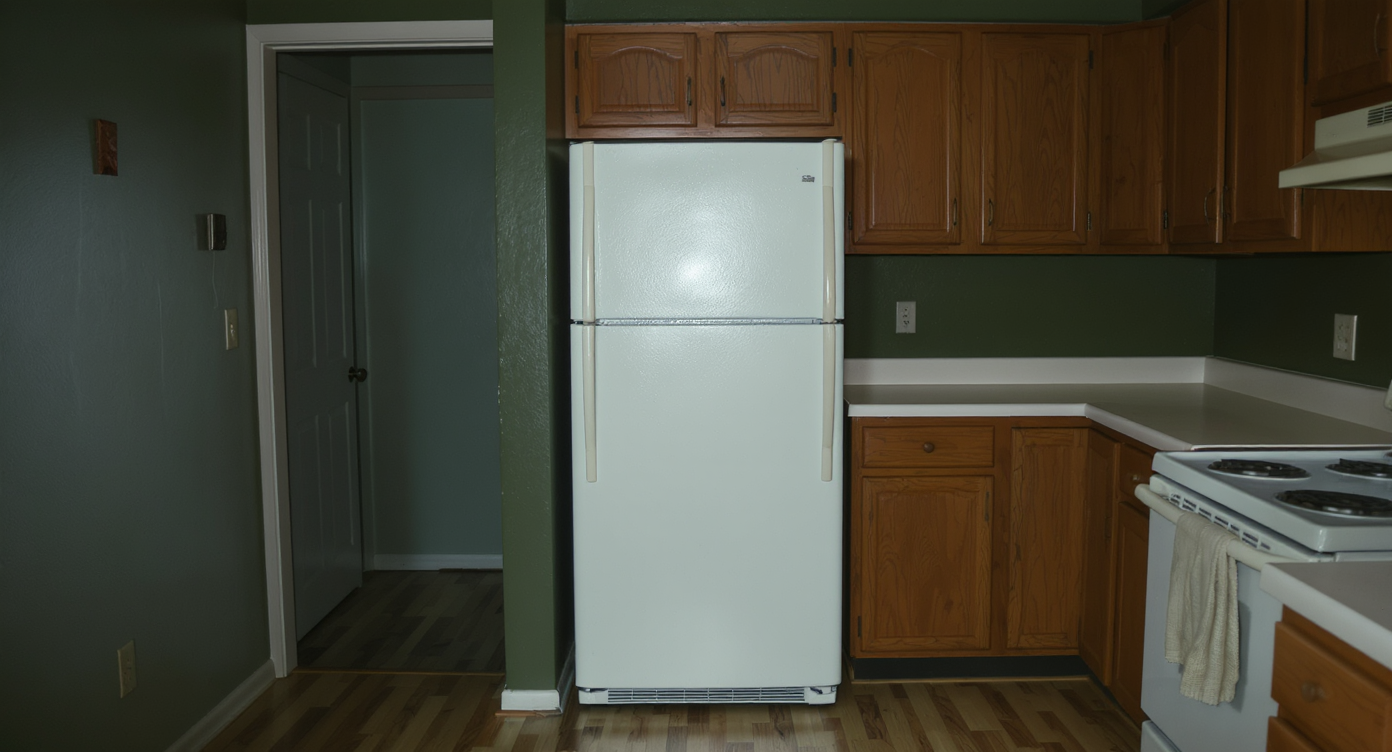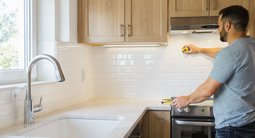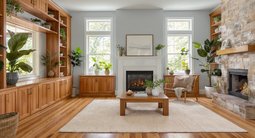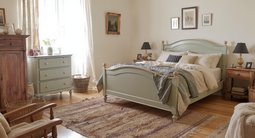TL;DR
Tried a dark green kitchen with brown cabinets and a white fridge and it feels heavy? Use these eight fixes to rebalance color, lighting, and sheen. You’ll learn how to make a white fridge blend, choose the right paint sheen, and test lighter greens — easy DIY home décor projects for small spaces that actually work.
When color courage backfires

When dark green feels mismatched and moody, small changes start the journey toward a polished kitchen.
Tried to leave your all-white comfort zone and now your kitchen feels moody, mismatched, and unwelcoming? You’re not alone. Many homeowners jump to a bold kitchen paint color, only to realize the space suddenly reads darker, the white fridge screams for attention, and the cabinet tone isn’t playing nice with the walls.
Here’s the thing: this isn’t a failure — it’s a half-finished story. With a few targeted tweaks, a dark green kitchen can look intentional and elevated, even with budget vinyl floors and existing brown cabinets. Designers often say kitchens succeed or fail on three levers: color contrast, paint sheen, and lighting. Adjust those, and the room changes fast.
Below, you’ll find eight DIY home décor fixes that tackle those levers directly — no gut renovation, no perfection required. If you love the gold sink and pulls, we’ll help them shine. If you hate the green, we’ll guide you to the right shade. Either way, you’ll end up with a kitchen that feels chosen, not chaotic.
A clear plan beats repainting everything white
Before grabbing the primer, pause. A good plan can save two weekends and three coats of regret. Think in layers: kitchen paint colors, cabinet tone, white fridge strategy, and small-space lighting. Early in the process, aim for a simple palette: one dominant color, one supportive neutral, and a metal finish you repeat at least three times.
For 2025 design trends, budget decorating ideas reward restraint. In small kitchens, short-tail essentials like small-space hacks, dark green kitchen, and brown cabinets matter — but they only sing when the lighting and sheen are right. Use the fixes below to sequence your decisions: disguise the fridge, right-size the green, soften the sheen, then warm up the light. The transformation is cumulative.
Anecdote
A homeowner I worked with painted their white fridge to match the cabinets using bonding primer and enamel spray; the result looked factory-made. Another client built slim brass-and-glass shelves above a counter-depth fridge, repeating the warm metal three times — faucet, pulls, shelves — and the whole moody green palette suddenly felt curated instead of heavy.
DIY HACKS & TRICKS
01. The Fridge Disappearing Act (white fridge fix)
A counter-depth fridge sits roughly 5–6 inches shallower than standard, instantly reducing visual bulk beside dark cabinets. If new isn’t in the cards, wraps, paint, and magnetic panels make a white fridge blend with brown cabinets and green walls.
What it is: A fast, budget makeover that makes the white box stop shouting. Vinyl appliance wraps, color-matched appliance paint, or large magnetic skins create a coordinated front.
How it works: Experts recommend peel-and-stick vinyl or appliance epoxy over a lightly sanded, degreased surface. Keep vents clear and avoid wrapping door gaskets. If painting, use bonding primer plus enamel or appliance spray; handles can take plastic-safe paint. As a rule of thumb, match the fridge to either the cabinet color or wall color, not a third tone, to lower contrast.
- Tip 1: Measure twice — add 1–2 inches per edge for wrap trimming.
- Tip 2: Try a deep green, warm taupe, or matte “stainless” vinyl to echo hardware.
- Tip 3: Add a brass or black handle kit to repeat your metal finish.
- Alt-text idea: "White fridge wrapped in deep green vinyl, blending with dark green wall and brown cabinets."
02. Go One Shade Lighter (green that works in small kitchens)
In narrow kitchens, aim for a wall color LRV around 35–55 when cabinets and counters are dark; it keeps depth without turning cave-like. Lighter sage greens often read softer under warm light.
What it is: A controlled pivot from charcoal green to softened sage or muted olive that still honors your bold streak.
How it works: Paint three 24×36 foam boards and move them around day and night; greens shift dramatically after sunset. Designers often advise washable matte or eggshell on smooth walls, satin on high-traffic kitchen areas. If you love your gold hardware, choose a green with a hint of warmth so the metal doesn’t look brassy.
- Tip 1: Test at the window wall and the wall opposite it; they read differently.
- Tip 2: Sample a warm white ceiling to bounce light back down.
- Tip 3: Pair with a cream trim to soften contrast with brown cabinets.
- Alt-text idea: "Sage green paint swatches taped beside brown cabinet and gold pull."
03. Color Drenching, Edited (balance dark walls and trim)
Color-drenching works best when the ceiling or floor provides relief; drenching everything dark reduces perceived width. If you drench, keep the ceiling a warm white (LRV 85+) for lift.
What it is: Painting multiple surfaces one color for a seamless, high-design look — with strategic breaks so the kitchen still breathes.
How it works: Follow a 60/30/10 ratio: 60 percent main wall color, 30 percent supportive neutral (ceilings/trim), 10 percent accent (metals, art). Frame dark walls with crisp trim or a lighter cabinet color so edges don’t blur. In a pass-through kitchen, carry the color onto the adjacent short wall to avoid a single “stuck-on” accent.
- Tip 1: Keep upper trim or crown lighter to outline the room.
- Tip 2: Repeat the wall color on a small accessory across the room for continuity.
- Alt-text idea: "Dark green wall with white crown trim outlining a narrow kitchen."
04. The Sheen Shift Strategy (matte vs satin)
Satin finishes in kitchens balance cleanability and forgiveness; high gloss exaggerates paneling and roller marks. A sheen change alone can calm a busy wall.
What it is: Swapping glare for glow so color reads richer and smoother.
How it works: On textured or imperfect walls, eggshell or low-sheen satin reduces highlights from under-cabinet lights. Reserve semi-gloss for trim. If repainting the same color, one coat of the right sheen can fix what looked “off” without changing the hue.
- Tip 1: Roll in one direction under strong light to spot lap marks.
- Tip 2: Use a 3/8-inch nap roller for most walls; it minimizes orange peel.
- Alt-text idea: "Side-by-side wall panels showing glossy vs satin green paint under warm light."
05. Layer the Light, Warm the Tone (small kitchen lighting)
Target 50–70 foot-candles on work surfaces, with bulbs at 2700K–3000K to flatter greens and wood. Layer ambient, task, and accent light for depth.
What it is: A simple lighting plan that makes moody color feel intentional, not gloomy.
How it works: Add 4-inch LED cans spaced 4–6 feet, under-cabinet strips for task light, and a warm diffuser fixture or two sconces for ambient glow. Dimmers let dark green shift from dramatic to cozy. Many regret dark paint at night because of cool, harsh bulbs; warmer lamps fix that fast.
- Tip 1: Choose 90+ CRI bulbs so greens stay true.
- Tip 2: Hide LED tape under cabs; aim lumens at the counter, not your eyes.
- Alt-text idea: "Under-cabinet LED lighting illuminating green backsplash and butcher block."
06. Balance the Browns (cabinet color calls)
When brown cabinets meet black counters and dark walls, lighten one element for relief. Experts suggest painting cabinets a warm white, greige, or a lighter green to break up the heaviness.
What it is: A strategic cabinet repaint or hardware refresh to harmonize undertones.
How it works: If your cabinets skew very warm, choose a neutral with a soft green-gray cast so they don’t fight the walls. Swap to lighter brass pulls for contrast. As a rule, repeat your metal finish three times: faucet, hardware, and one open-shelf accent.
- Tip 1: Prime with bonding primer; sand lightly between coats for a factory feel.
- Tip 2: Consider taupe lowers and creamy uppers to lift the room.
- Alt-text idea: "Brown cabinet door beside painted greige sample and brass pull."
07. Verticals + Warm Metals (make it feel designed)
Raising the eye line with shelving or a tall cabinet surround helps the fridge recede. Repeating gold or brass three times ties the sink and pulls to the room.
What it is: DIY open shelves, glass-and-brass brackets, or a simple cabinet bridge above the fridge.
How it works: Add a 12–14 inch deep shelf above the fridge for baskets and plants; align the top with nearby uppers for a clean datum. A slim rail with brass hooks brings function and shimmer to a dark wall. One homeowner I spoke with built brass-tube shelf supports and tempered glass shelves — the glow made their moody green feel luxe.
- Tip 1: Match brass tones so they don’t clash; warm brushed brass is forgiving.
- Tip 2: Style with wood cutting boards to introduce natural texture.
- Alt-text idea: "Brass-bracket open shelves above a counter-depth fridge on a green wall."
08. Style the Light Back In (textiles, art, and white accents)
White and cream accents can balance a dark green kitchen without repainting everything white. A runner, frames, and airy curtains soften contrast fast.
What it is: Finishing layers that brighten and connect zones.
How it works: Use a 2×8 or 2.5×9 runner to elongate a galley. Add white frames around art on the green wall so the white fridge no longer feels like the only light object. Two or three potted plants near the window bring life and a natural palette bridge between brown cabinets and green walls.
- Tip 1: Choose a washable runner with a cream ground and moss accents.
- Tip 2: Add a cork or wood message board to warm the fridge side panel.
- Alt-text idea: "Cream-framed art and striped runner brightening a dark green galley kitchen."
What ties these ideas together
What ties these ideas together isn’t repainting everything white — it’s recalibrating contrast. Each fix reduces one jarring element, and together they turn resourcefulness into design clarity.
I’ve seen it happen: a homeowner paints the fridge to match the cabinets and swaps to warmer bulbs, and suddenly the same green that felt oppressive reads intentional. Another moved from charcoal green to a sage two steps lighter and sighed with relief. Your kitchen can get there, too.
Visualize Before You DIY
Previewing color and lighting changes on your own room photo prevents expensive re-dos. A virtual mockup lets you test greens, fridge wraps, and lighting temperature in minutes.
Upload a photo to ReimagineHome, try a lighter green, add a brass shelf, or wrap the fridge digitally, and compare day vs night simulations. It’s not just inspiration — it’s a confidence tool that saves time, paint, and second-guessing.
Visualization Scenario
Upload a photo of your galley kitchen to ReimagineHome, test a lighter sage on the long wall, wrap the fridge in matte green, add under-cabinet lighting, and compare warm (2700K) vs cool (4000K) bulbs. Save your favorite version and bring it to the paint store with confidence.
FAQ
How do I make a white fridge blend with dark cabinets?
Wrap it in vinyl, paint it with appliance epoxy, or add magnetic panels in a matching color. Matching the fridge to either the cabinets or the wall reduces contrast instantly.
What’s the best paint sheen for kitchen walls?
Satin or washable matte works best; it balances cleanability with fewer glare highlights. Reserve semi-gloss for trim and doors.
How can I fix a dark green kitchen that feels too cave-like?
Lighten the green by one to two shades, switch bulbs to 2700K–3000K, and add under-cabinet lighting. Keep the ceiling a warm white to bounce light.
Should I repaint the cabinets or the walls if everything feels heavy?
Lightening one big surface is enough; walls are faster, cabinets are more transformative. Choose the cheaper, faster change first and reassess.
What’s the best way to test kitchen paint colors?
Paint large 24×36 sample boards and view them morning, afternoon, and evening. Greens shift most under nighttime lighting, so test with your actual bulbs.
Make peace with color — then make it yours
Color bravery rarely looks perfect mid-process. If your dark green kitchen feels wrong right now, it’s likely a mix issue — not a personality flaw or a doomed idea. Tame the fridge, choose the right sheen, warm the lights, and consider a softer green or lighter cabinets to open the space without erasing your vision.
In 2025, design isn’t about defaulting to white; it’s about editing with intention. Make a few precise moves, live with them for a week, and let the room tell you what it needs next. And when you’re ready to test the next change, use ReimagineHome to see it before you commit.
.svg)

.svg)
.jpg)













.png)